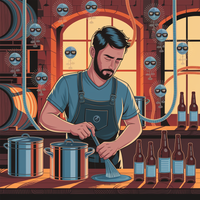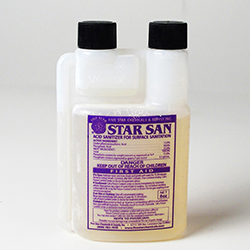How to Clean and Sanitize Home Brewing Equipment
Posted by Matteo Lahm on 29th May 2024
Clean, Sanitize then Sanitize: The Brewer's Mantra.
Let’s talk about the uninvited guests at your brewing party. They are those microscopic party crashers that can turn your delightful brew into a science experiment gone wrong. Bacteria and wild yeast are like the annoying neighbors who show up uninvited, eat all your food, and then refuse to leave. Let's help you clean up after them, and make sure they don't come back.
Granted, bacteria and wild yeast aren't all bad. Some of them are actually quite useful in the right context. But when it comes to brewing, they're about as welcome as a skunk at a garden party.
Bacteria come in two main varieties: gram-positive and gram-negative. They're not just positive and negative in name and they bring their own unique brand of chaos to your brew. Let’s get better acquainted with them.
Gram-positive bacteria, like Lactobacillus and Pediococcus, are the hardy types. They thrive in conditions that would make other bacteria pack up their bags and leave. They're the ones who, when the going gets tough, get going, and boy, do they get going on your beer equipment if it's not properly sanitized after use.
These bacteria are like microscopic squatters. They find a nice, cozy spot on your equipment where some residue has been left behind and they set up camp. And they're not just content with setting up a small tent and a campfire. With the right conditions, they start building a whole bacterial metropolis.
They multiply faster than rabbits in springtime, turning that small spot of residue into a thriving bacterial city. And like any city, they produce waste. But instead of trash and sewage, their waste products are acids and other compounds that can spoil your beer.
Imagine sipping your carefully crafted beer, expecting a symphony of flavors, only to get a mouthful of sour milk. That's the handiwork of these gram-positive bacteria. They turn the sugars in your beer into lactic acid, giving it a sour taste that's about as welcome as a mosquito at a nudist colony.
The worst part is that these bacteria are tough. They can survive in conditions that would make other bacteria throw in the towel. They can withstand high temperatures, low pH, and even the presence of alcohol. They're like the cockroaches of the bacterial world.
So, if you don't want your beer to taste like a psychotic dairy product, you need to ensure your equipment is properly sanitized after use. Because once these bacteria set up camp, they're harder to evict than a bad tenant and you don't want to be the landlord.
Now, let's turn our attention to the party poopers of the bacterial world: the gram-negative bacteria, specifically Salmonella typhimurium and E. coli. These microscopic miscreants are not just a nuisance; they're a downright hazard.

These bacteria are like tiny, unwanted chefs in your brewing kitchen. They get their grubby little paws on your carefully selected ingredients and start cooking up a storm. But instead of a gourmet meal, they produce a smorgasbord of unwanted by-products adding unwanted flavors and smells to your brew.
Worse yet, these bacteria also have a knack for disrupting the fermentation process. They interfere with your chosen yeast, preventing it from doing its job.
Finally, let's talk about wild yeast. If it gets into your brew, it'll throw a wild party, leaving behind a hazy, heterogeneous mixture and a bunch of unpleasant flavors and smells.
Wild yeast simply doesn't play by the rules. It doesn't care about your carefully planned fermentation process. It doesn't care about the delicate balance of flavors you're trying to achieve. It is like a horrible boss who unloads work on you before your family vacation so he can play golf. When wild yeast gets into your brew, it is not just a spoiler. It consumes all the sugar it can find, and leaves behind a mess of unwanted by-products.
If that was not bad enough, it gets even worse. Wild yeast is a master of hide and seek. It can lurk in the nooks and crannies of your unsanitized equipment. And once it's in, it's hard to get out. It multiplies faster than a rumor in a small town, quickly taking over your brew.
Despite all the gross unpleasantries, there is not only hope, but a solution! These unwelcome guests can be shown the door with a little bit of elbow grease and a lot of sanitizing. And it is not just cleaning and sanitizing, it is how, and when.
After you've finished brewing, it's time to roll up your sleeves, and not for a quick rinse under the tap. No, you need to thoroughly clean your equipment and you need to use cleaners that are specifically formulated for beer making equipment. They don't leave behind residues. Residues are like a five-star hotel for bacteria and wild yeast, providing them with everything they need to thrive. Once your equipment is squeaky clean, it's time to bring out the big guns: the sanitizer. However, you can't just sanitize once and call it a day. It's a three-step process. Clean your gear well, sanitize and store it, then sanitize it again before use.
If you follow these steps, you only need to sanitize it before your next batch if you store it properly. Keep it out of your kitchen. Don’t just put it on a random shelf. Your beer equipment must be allowed to rest in a clean environment. If not, there are other unsavory microscopic characters that can set up shop. Plastic totes with lids are cheap and effective, and you might even want to spray them with a sanitizing solution as well. You cannot be too careful.
The most important thing to understand is that while sanitizing is 99.99% effective, it is still not 100%. The goal is to limit potential contaminants as much as possible. A few bandits are much easier to defeat than an army. That is why you need to clean, sanitize then sanitize again. Following this methodology limits their presence as much as possible short of medical-grade sterilization. The only thing that should be in your beer is the ingredients you've chosen, not a bunch of uninvited microscopic party crashers. Cheers!


